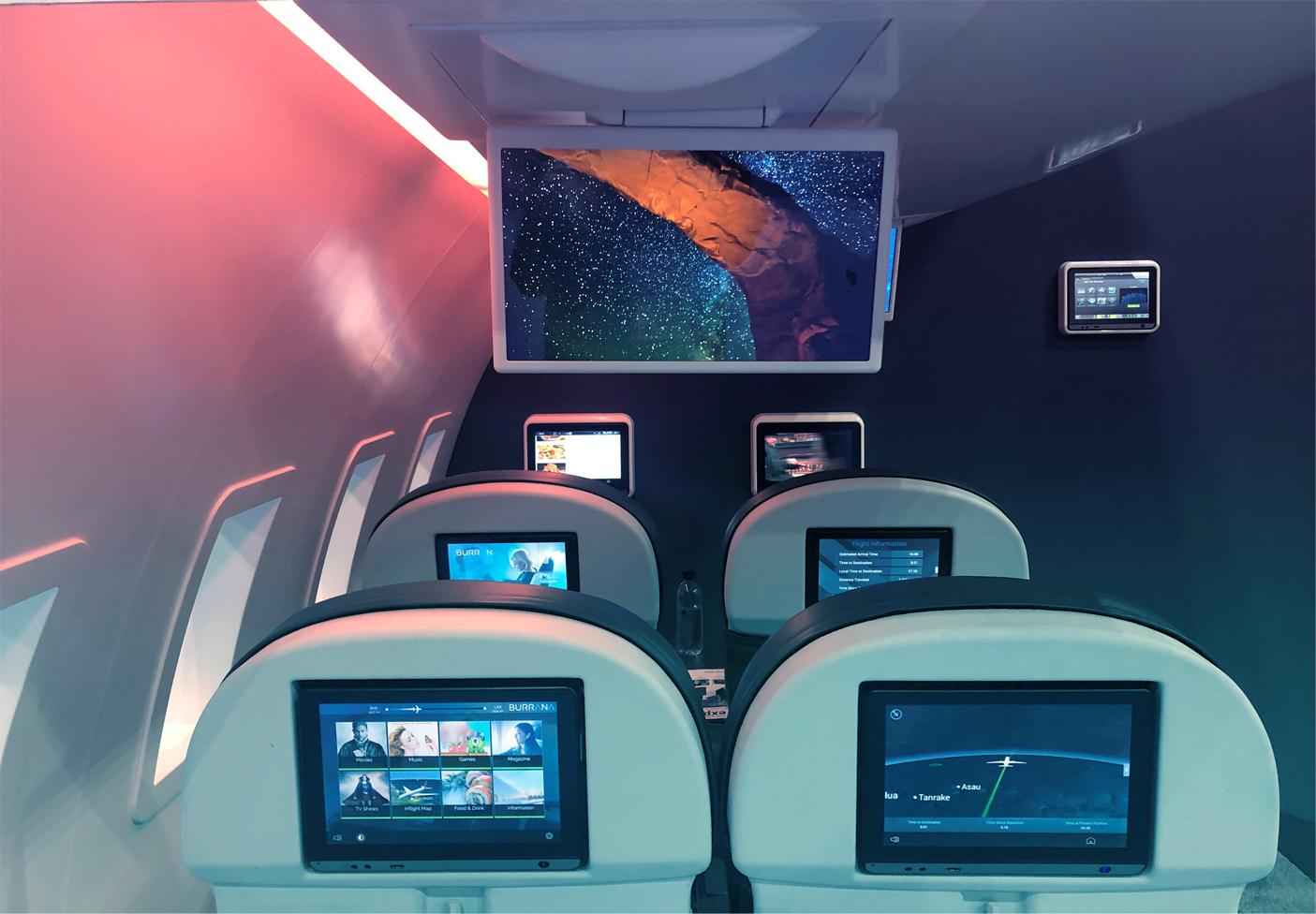
Time was – and it’s not so long ago – when the idea of inflight entertainment systems were the domain of long-haul aircraft and the idea of communication systems sending emails from a handset wasn’t happening anywhere, never mind to-and-from aircraft.
Now, of course, inflight entertainment and/or communication (IFEC) systems are almost always on flights of much shorter range. After use on widebody aircraft, such equipment made its way onto the single-aisle workhorses. No reason, therefore, why crossover narrowbody jets such as the Airbus A220 and Embraer E-Jet families should not follow, given the sector lengths they regularly operate.
According to Daniel Galhardo, director of strategy, Embraer Commercial Aviation, the new generation of E-Jets – the E2 family – offers a complete portfolio of IFEC solutions. “These include wireless streaming entertainment to personal devices or seat backs, internet via Ka and Ku band and real-time TV (iPTV) and the In-Seat In-Flight Entertainment system,” he remarks.
“As an OEM, Embraer does not have a preferred option, but we do recognize that the use of personal devices instead of in-seat IFE is a strong trend that has been growing for a number of years. This trend continues to grow due to the COVID situation in which people wish to reduce their contact with shared surfaces,” Galhardo adds.
Anaïs Marzo da Costa, head of aircraft interiors marketing at Airbus, emphasizes that the A220 family was designed for multiple IFEC systems architecture integrations within the avionics bay, therefore not impinging onto the cargo volume. “The A220 IFEC offering covers the broadest range of functionalities, intended to satisfy all airline types and passengers’ entertainment preferences – from lightweight, versatile solutions to long haul-like passenger experiences,” she comments.
“Typical IFE solutions include: in-seat power, overhead video, latest generation AVOD and onboard wireless IFE from different suppliers, while connectivity solutions include broadband (Ka-Band from ViaSat, 2 Ku-Band from Gogo and Ku-Band by Panasonic) for onboard internet access and connected experiences. All these solutions are pre-certified and cater for short-haul passengers bringing their own personal device to longer haul in-seat video entertainment.
“Our special A220 feature is the overhead IFE solution unique to the A220,” Marzo da Costa continues. “It consists of a 4.3-inch fixed overhead screen at every passenger row, designed to provide video content such as safety videos, moving map, connecting gate information, destination videos and advertising.”
Observing carriers’ choices between embedded systems and simply providing streaming services to passengers’ own devices, the Airbus exec confirms that all A220s delivered have been fitted with IFE or an in-seat power supply. “Wireless IFEC solutions are increasingly popular options and we foresee this trend continuing to grow. Interestingly, travelers also enjoy the embedded systems and we now see the home-like multiscreen experience developing, with one screen being used to watch a video and another to surf the web, for example.”
At Embraer, Galhardo says that streaming IFE is usually preferred by airlines for domestic flights as it is a lighter than an embedded system. “The option that passengers are demanding most is internet connection, even on short flights,” he acknowledges. “So broadband solutions like Ka and Ku systems, as well as seat designs incorporating holders for personal electronic devices are becoming more popular.”
The aircraft OEMs have acknowledged that while they help with ideas, the final choice of IFEC systems rests with customers. And they have quite a range of providers from which to choose when looking for something to suit their A220 and E-Jet families.
David Pook, VP marketing and sales support for Burrana, say that the most applicable solutions from its RISE platform include the RISE Power and RISE Wireless IFE products. “The passenger demand for in-seat power has grown exponentially due to most travelers carrying up to three devices each (smartphone, laptop, tablet). Passengers are also not likely to have charged all devices to 100% capacity prior to boarding, so providing the basic option to charge devices is paramount,” he notes.
“Added to this is the appetite for airlines to offer passengers the ability to stream content direct to their personal devices, which also reduces weight and cost of ownership while delivering operational efficiencies and generating revenue through targeted advertising,” Pook states. “We have seen over the COVID pandemic with a growing need to reduce customer touchpoints in the cabin, both in-seat power and wireless IFE are primed to solve these issues.”
The VP believes some airlines will continue to require seatback IFE on their crossover jets, but is confident about Burrana’s prospects either way. “We have designed our platform with a single capable server to deliver increasing levels of value dependent on the customer requirement, a modular approach to adding features and functionality, easily scaled up or down now or later,” he remarks.

Thales says its entire portfolio of IFE solutions (both seatback and wireless), connectivity and digital services is suitable for airlines flying A220s and E-Jets. “Our long-term partner JetBlue has selected both in-seat IFE systems and connectivity for their new A220 and you see a similar approach taken by Delta and Air Canada,” the company states.
Choosing between embedded systems and streaming services depends on an airline’s brand strategy, according to Thales, although the company notes that through the COVID-19 crisis it has seen that airlines have remained committed to their in-seat IFE strategy. “We have observed an increase in demand for wireless IFE, but not at the expense of in-seat systems.”
Bluebox Aviation offers a range of W-IFE solutions relevant to these aircraft types, but according to head of marketing, Catherine Brown, Bluebox Wow – either in its battery-operated or aircraft-powered formats – is the most cost-effective way of deploying IFE. “More importantly, it allows airlines to reap the benefits of providing IFE both as a carrier and for passengers – lower deployment costs and less weight than embedded systems, passenger experience and engagement benefits, and revenue generation potential all support the business case for W-IFE,” she emphasises.
“Our customers include regional carriers large and small, and larger carriers with these aircraft in their mixed fleets. They’ve been able to enhance their inflight services by adding IFE or simply extending their existing IFE service into routes that didn’t have it previously thereby providing a more consistent passenger experience.” Brown cites Air Astana, with its Embraer E2s as an example of this.
“Through the pandemic, W-IFE has not only proven much more resilient in terms of new investments but also for maintaining inflight services, and on narrowbody aircraft in particular,” she continues. “Clearly the financial challenges carriers have faced have made any investment decision tougher, so the revenue generation potential of IFE– via onboard sales of food and beverages, destination activities/services, advertising – has been of particular interest during the pandemic and a key driver for some new deployments.
“Hygiene too has been front and center in our deployments, and an important and obvious benefit of W-IFE given that it is delivered via wireless streaming to passengers’ own personal devices – communicating onboard safety protocols; converting high-touch seat pocket materials and delivering these in a digital format (which, in the case of inflight magazines also helps reduce weight while preserving advertising revenue). Meanwhile, ordering of food and beverages from seats and via touch-free payments helps to minimize passenger/cabin-crew interaction under social distancing protocols,” Brown explains.
“With domestic and to an extent regional travel proving more resilient during the global pandemic, and likely to see recovery earlier and faster, we at Bluebox expect to continue to see even more interest from these carriers seeking to reap the rewards of enhancing their inflight service with W-IFE,” Brown summarizes.
Entertainment relies on variety and the range of IFEC systems from which to choose clearly adheres to that principle.





